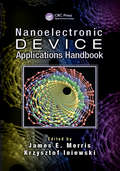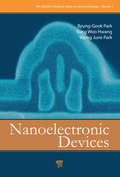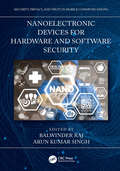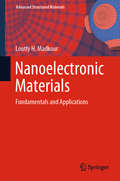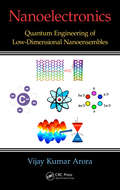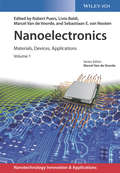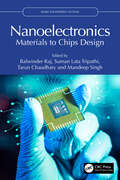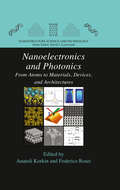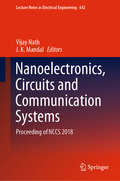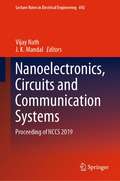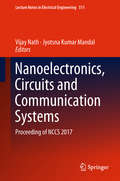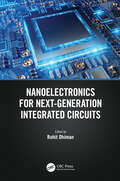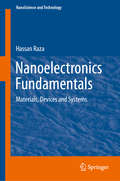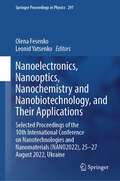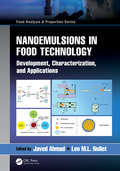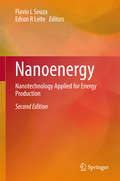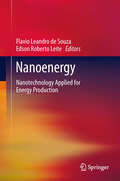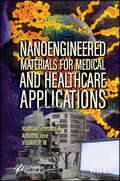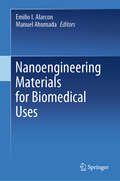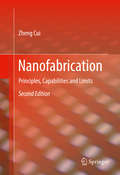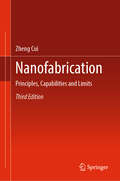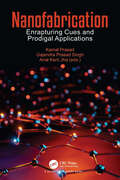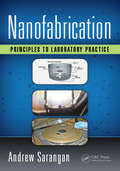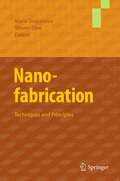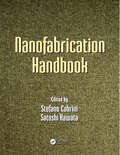- Table View
- List View
Nanoelectronic Device Applications Handbook (Devices, Circuits, and Systems #16)
by James E. Morris Krzysztof IniewskiNanoelectronic Device Applications Handbook gives a comprehensive snapshot of the state of the art in nanodevices for nanoelectronics applications. Combining breadth and depth, the book includes 68 chapters on topics that range from nano-scaled complementary metal–oxide–semiconductor (CMOS) devices through recent developments in nano capacitors and AlGaAs/GaAs devices. The contributors are world-renowned experts from academia and industry from around the globe. The handbook explores current research into potentially disruptive technologies for a post-CMOS world. These include: Nanoscale advances in current MOSFET/CMOS technology Nano capacitors for applications such as electronics packaging and humidity sensors Single electron transistors and other electron tunneling devices Quantum cellular automata and nanomagnetic logic Memristors as switching devices and for memory Graphene preparation, properties, and devices Carbon nanotubes (CNTs), both single CNT and random network Other CNT applications such as terahertz, sensors, interconnects, and capacitors Nano system architectures for reliability Nanowire device fabrication and applications Nanowire transistors Nanodevices for spintronics The book closes with a call for a new generation of simulation tools to handle nanoscale mechanisms in realistic nanodevice geometries. This timely handbook offers a wealth of insights into the application of nanoelectronics. It is an invaluable reference and source of ideas for anyone working in the rapidly expanding field of nanoelectronics.
Nanoelectronic Devices
by Byung-Gook Park Sung Woo Hwang Young June ParkThis book provides readers with the knowledge in fundamentals of nanoelectronic devices. The authors build the principles of nanoelectronic devices based on those of microelectronic devices wherever possible and introduce the inherently nanoelectronic principles gradually. They briefly review quantum mechanics and solid-state physics that can form the basis of semiconductor device physics. The book also covers the basics of electron transport and p–n junctions, develops the operations of MOS capacitors and MOSFETs, and introduces some basic CMOS circuits. The last chapter is devoted to the nano-biotechnology application of field-effect transistors.
Nanoelectronic Devices for Hardware and Software Security (Security, Privacy, and Trust in Mobile Communications)
by Balwinder Raj Arun Kumar SinghNanoelectronic Devices for Hardware and Software Security has comprehensive coverage of the principles, basic concepts, structure, modeling, practices, and circuit applications of nanoelectronics in hardware/software security. It also covers the future research directions in this domain. In this evolving era, nanotechnology is converting semiconductor devices dimensions from micron technology to nanotechnology. Nanoelectronics would be the key enabler for innovation in nanoscale devices, circuits, and systems. The motive for this research book is to provide relevant theoretical frameworks that include device physics, modeling, circuit design, and the latest developments in experimental fabrication in the field of nanotechnology for hardware/software security. There are numerous challenges in the development of models for nanoscale devices (e.g., FinFET, gate-all-around devices, TFET, etc.), short channel effects, fringing effects, high leakage current, and power dissipation, among others. This book will help to identify areas where there are challenges and apply nanodevice and circuit techniques to address hardware/software security issues.
Nanoelectronic Materials: Fundamentals and Applications (Advanced Structured Materials #116)
by Loutfy H. MadkourThis book presents synthesis techniques for the preparation of low-dimensional nanomaterials including 0D (quantum dots), 1D (nanowires, nanotubes) and 2D (thin films, few layers), as well as their potential applications in nanoelectronic systems. It focuses on the size effects involved in the transition from bulk materials to nanomaterials; the electronic properties of nanoscale devices; and different classes of nanomaterials from microelectronics to nanoelectronics, to molecular electronics. Furthermore, it demonstrates the structural stability, physical, chemical, magnetic, optical, electrical, thermal, electronic and mechanical properties of the nanomaterials. Subsequent chapters address their characterization, fabrication techniques from lab-scale to mass production, and functionality. In turn, the book considers the environmental impact of nanotechnology and novel applications in the mechanical industries, energy harvesting, clean energy, manufacturing materials, electronics, transistors, health and medical therapy. In closing, it addresses the combination of biological systems with nanoelectronics and highlights examples of nanoelectronic–cell interfaces and other advanced medical applications. The book answers the following questions: • What is different at the nanoscale? • What is new about nanoscience? • What are nanomaterials (NMs)? • What are the fundamental issues in nanomaterials? • Where are nanomaterials found? • What nanomaterials exist in nature? • What is the importance of NMs in our lives? • Why so much interest in nanomaterials? • What is at nanoscale in nanomaterials? • What is graphene? • Are pure low-dimensional systems interesting and worth pursuing? • Are nanotechnology products currently available? • What are sensors? • How can Artificial Intelligence (AI) and nanotechnology work together? • What are the recent advances in nanoelectronic materials? • What are the latest applications of NMs?
Nanoelectronics: Quantum Engineering of Low-Dimensional Nanoensembles
by Vijay Kumar AroraBrings the Band Structure of Carbon-Based Devices into the LimelightA shift to carbon is positioning biology as a process of synthesis in mainstream engineering. Silicon is quickly being replaced with carbon-based electronics, devices are being reduced down to nanometer scale, and further potential applications are being considered. While traditionally, engineers are trained by way of physics, chemistry, and mathematics, Nanoelectronics: Quantum Engineering of Low-Dimensional Nanoensembles establishes biology as an essential basic science for engineers to explore. Unifies Science and Engineering: from Quantum Physics to NanoengineeringDrawing heavily on published papers by the author, this research-driven text offers a complete review of nanoelectronic transport starting from quantum waves, to ohmic and ballistic conduction, and saturation-limited extreme nonequilibrium conditions. In addition, it highlights a new paradigm using non-equilibrium Arora’s Distribution Function (NEADF) and establishes this function as the starting point (from band theory to equilibrium to extreme nonequilibrium carrier statistics). The author focuses on nano-electronic device design and development, including carbon-based devices, and provides you with a vantage point for the global outlook on the future of nanoelectronics devices and ULSI.Encompassing ten chapters, this illuminating text: Converts the electric-field response of drift velocity into current–voltage relationships that are driven by the presence of critical voltage and saturation current arising from the unidirectional drift of carriers Applies the effect of these scaled-down dimensions to nano-MOSFET (metal–oxide–semiconductor field-effect transistor) Considers specialized applications that can be tried through a number of suggested projects that are all feasible with MATLAB® codes Nanoelectronics: Quantum Engineering of Low-Dimensional Nanoensembles contains the latest research in nanoelectronics, identifies problems and other factors to consider when it comes to nanolayer design and application, and ponders future trends.Print Versions of this book also include access to the ebook version.
Nanoelectronics: Materials, Devices, Applications, 2 Volumes
by Livio Baldi Marcel Van de Voorde Robert Puers Sebastiaan E. van NootenOffering first-hand insights by top scientists and industry experts at the forefront of R&D into nanoelectronics, this book neatly links the underlying technological principles with present and future applications. A brief introduction is followed by an overview of present and emerging logic devices, memories and power technologies. Specific chapters are dedicated to the enabling factors, such as new materials, characterization techniques, smart manufacturing and advanced circuit design. The second part of the book provides detailed coverage of the current state and showcases real future applications in a wide range of fields: safety, transport, medicine, environment, manufacturing, and social life, including an analysis of emerging trends in the internet of things and cyber-physical systems. A survey of main economic factors and trends concludes the book. Highlighting the importance of nanoelectronics in the core fields of communication and information technology, this is essential reading for materials scientists, electronics and electrical engineers, as well as those working in the semiconductor and sensor industries.
Nanoelectronics: Materials to Chips Design (Smart Engineering Systems: Design and Applications)
by Balwinder Raj, Suman Lata Tripathi, Tarun Chaudhary and Mandeep SinghThis book exhibits a unique way of explaining nanomaterials and devices and analyzing their design parameters to meet the sub-nanoregime challenges for low-power chip design. Since process variability, device sizing, and power supply scaling are ongoing challenges in very large-scale integration (VLSI) circuit designs, this book highlights the conventional and novel nanomaterials, devices and circuits, leakage current mitigation techniques, and other important trade-offs along with exhaustive analysis. More focus has been placed throughout the book on various trade-offs for high-speed and low-power VLSI devices and circuits co-design. This book: • Discusses advanced nano-semiconductor devices such as FinFET, nanowires, tunnel field-effect transistors, carbon nanotube field-effect transistors, and high-electron-mobility transistors. • Presents high-performance semiconductor devices at nanoscale technology nodes for the analysis of quantum effects and their impact on circuits and systems. • Covers power dissipation and reduction techniques for high-performance devices. • Explains both silicon and non-silicon devices for various applications like digital logic and analog/radio frequency applications. • Examines the difficulties and practical design approaches for extremely low-power analog-integrated circuits. It is primarily written for senior undergraduates, graduate students, and academic researchers in the fields of electrical engineering, electronics and communications engineering, materials science, nanoscience, and nanotechnology.
Nanoelectronics and Photonics
by Federico Rosei Anatoli KorkinNanoelectronics and Photonics provides a fundamental description of the core elements and problems of advanced and future information technology. The authoritative book collects a series of tutorial chapters from leaders in the field covering fundamental topics from materials to devices and system architecture, and bridges the fundamental laws of physics and chemistry of materials at the atomic scale with device and circuit design and performance requirements.
Nanoelectronics, Circuits and Communication Systems: Proceeding of NCCS 2018 (Lecture Notes in Electrical Engineering #642)
by J. K. Mandal Vijay NathThis book features selected papers presented at the Fourth International Conference on Nanoelectronics, Circuits and Communication Systems (NCCS 2018). Covering topics such as MEMS and nanoelectronics, wireless communications, optical communications, instrumentation, signal processing, the Internet of Things, image processing, bioengineering, green energy, hybrid vehicles, environmental science, weather forecasting, cloud computing, renewable energy, RFID, CMOS sensors, actuators, transducers, telemetry systems, embedded systems, and sensor network applications in mines, it offers a valuable resource for young scholars, researchers, and academics alike.
Nanoelectronics, Circuits and Communication Systems: Proceeding of NCCS 2019 (Lecture Notes in Electrical Engineering #692)
by J. K. Mandal Vijay NathThis book features selected papers presented at the Fifth International Conference on Nanoelectronics, Circuits and Communication Systems (NCCS 2019). It covers a range of topics, including nanoelectronic devices, microelectronics devices, material science, machine learning, Internet of things, cloud computing, computing systems, wireless communication systems, advances in communication 5G and beyond. Further, it discusses VLSI circuits and systems, MEMS, IC design and testing, electronic system design and manufacturing, speech signal processing, digital signal processing, FPGA-based wireless communication systems and FPGA-based system design, Industry 4.0, e-farming, semiconductor memories, and IC fault detection and correction.
Nanoelectronics, Circuits and Communication Systems: Proceeding of NCCS 2017 (Lecture Notes in Electrical Engineering #511)
by Vijay Nath Jyotsna Kumar MandalThis book features selected papers presented at Third International Conference on Nanoelectronics, Circuits and Communication Systems (NCCS 2017). Covering topics such as MEMS and nanoelectronics, wireless communications, optical communication, instrumentation, signal processing, Internet of Things, image processing, bioengineering, green energy, hybrid vehicles, environmental science, weather forecasting, cloud computing, renewable energy, RFID, CMOS sensors, actuators, transducers, telemetry systems, embedded systems, and sensor network applications in mines, it is a valuable resource for young scholars, researchers, and academics.
Nanoelectronics for Next-Generation Integrated Circuits
by Rohit DhimanThe incessant scaling of complementary metal-oxide semiconductor (CMOS) technology has resulted in significant performance improvements in very-large-scale integration (VLSI) design techniques and system architectures. This trend is expected to continue in the future, but this requires breakthroughs in the design of nano-CMOS and post-CMOS technologies. Nanoelectronics refers to the possible future technologies beyond conventional CMOS scaling limits. This volume addresses the current state-of-the-art nanoelectronic technologies and presents potential options for next-generation integrated circuits. Nanoelectronics for Next-generation Integrated Circuits is a useful reference guide for researchers, engineers, and advanced students working on the frontier of the design and modeling of nanoelectronic devices and their integration aspects with future CMOS circuits. This comprehensive volume eloquently presents the design methodologies for spintronics memories, quantum-dot cellular automata, and post-CMOS FETs, including applications in emerging integrated circuit technologies.
Nanoelectronics Fundamentals: Materials, Devices and Systems (NanoScience and Technology)
by Hassan RazaThis book covers the state of the art in the theoretical framework, computational modeling, and the fabrication and characterization of nanoelectronics devices. It addresses material properties, device physics, circuit analysis, system design, and a range of applications. A discussion on the nanoscale fabrication, characterization and metrology is also included. The book offers a valuable resource for researchers, graduate students, and senior undergraduate students in engineering and natural sciences, who are interested in exploring nanoelectronics from materials, devices, systems, and applications perspectives.
Nanoelectronics, Nanooptics, Nanochemistry and Nanobiotechnology, and Their Applications: Selected Proceedings of the 10th International Conference on Nanotechnologies and Nanomaterials (NANO2022), 25–27 August 2022, Ukraine (Springer Proceedings in Physics #297)
by Olena Fesenko Leonid YatsenkoThis book highlights some of the latest advances in nanotechnology and nanomaterials from leading researchers in Ukraine, Europe and beyond. It features contributions presented at the 10th International Science and Practice Conference Nanotechnology and Nanomaterials (NANO2022), which was held on August 25-27, 2022 at Lviv House of Scientists, and was jointly organized by the Institute of Physics of the National Academy of Sciences of Ukraine, University of Tartu (Estonia), University of Turin (Italy), and Pierre and Marie Curie University (France). Internationally recognized experts from a wide range of universities and research institutions share their knowledge and key findings across diverse areas ranging from quantum optics and nanoelectonics to biophysics.The book will be interesting for leading scientists, advanced undergraduate and graduate students in nanoelectronics, optics, bio-and chemical engineering. This book’s companion volume also addresses topics such as nanostructured surface, nanomaterials, and its applications.
Nanoemulsions in Food Technology: Development, Characterization, and Applications (Food Analysis & Properties)
by Leo M.L. Nollet Javed AhmadAs of late, greater efforts are being made in the use of nanoemulsion techniques to encapsulate, protect, and deliver functional compounds for food applications, given their advantages over conventional emulsification techniques. In addition, delivery systems of nano-scale dimensions use low-energy emulsification methods and exclude the need of any solvent, heat, or sophisticated instruments in their production. Divided into three sections, Nanoemulsions in Food Technology: Development, Characterization, and Applications will provide in-depth information and comprehensive discussion over technologies, physical and nanostructural characterization, as well as applicability of the nanoemulsion technique in food sciences. It describes the techniques involved in nanoemulsion characterization, mainly dealing with interfacial and nanostructural characterization of nanoemulsions, different physical characterization techniques, as well as various imaging and separation techniques involved in its characterization. Key Features Provides a detailed discussion about the technology of nanoemulsion Explains how nanoemulsion technique is helpful in using essential oils of different biological sources Presents methods of preparation and recent advancements in manufacturing along with stability perspectives of this technique. Discusses recent advancements in manufacturing and reviews the stability perspectives of nanoemulsion techniques This book contains in-depth information on a technology overview, physical and nanostructural characterization, as well as applicability of the nanoemulsion technique in food sciences. It is a concise body of information that is beneficial to researchers, industries, and students alike. The contributing authors are drawn from a rich blend of experts in various areas of scientific field exploring nanoemulsion techniques for wider applications. Also available in the Food Analysis and Properties Series: Sequencing Technologies in Microbial Food Safety and Quality, edited by Devarajan Thangardurai, Leo M.L. Nollet, Saher Islam, and Jeyabalan Sangeetha (ISBN: 9780367351182) Chiral Organic Pollutants: Monitoring and Characterization in Food and the Environment, edited by Edmond Sanganyado, Basil K. Munjanja, and Leo M.L. Nollet (ISBN: 9780367429232) Analysis of Nanoplastics and Microplastics in Food, edited by Leo. M.L. Nollet and Khwaja Salahuddin Siddiqi (ISBN: 9781138600188)
Nanoenergy
by Edson Leite Flavio Leandro de SouzaLow dimensional systems have revolutionized the science and technology in several areas. However, their understanding is still a great challenge for the scientific community. Solar energy conversion devices based on nanostructured materials have shown exceptional gains in efficiency and stability. In this context, nanostructures allow an improvement of surface properties, transport and charge transfer, as well as direct application as sensors and storage devices and energy conversion. This book discuss the recent advances and future trends of the nanoscience in solar energy conversion and storage. It explores and discusses recent developments both in theory as well as in experimental studies and is of interest to materials scientists, chemists, physicists and engineers.
Nanoenergy
by Edson Roberto Leite Flavio Leandro de SouzaLow dimensional systems have revolutionized the science and technology in several areas. However, their understanding is still a great challenge for the scientific community. Solar energy conversion devices based on nanostructured materials have shown exceptional gains in efficiency and stability. In this context, nanostructures allow an improvement of surface properties, transport and charge transfer, as well as direct application as sensors and storage devices and energy conversion. This book discuss the recent advances and future trends of the nanoscience in solar energy conversion and storage. It explores and discusses recent developments both in theory as well as in experimental studies and is of interest to materials scientists, chemists, physicists and engineers.
Nanoengineered Materials for Medical and Healthcare Applications
by Radhakrishnan E. K. Ashitha Jose Visakh P. M.This book is a comprehensive guide on the new-generation nanoengineered materials’ contribution to the ongoing development of medical devices and other healthcare applications. Nanotechnology has revolutionized cutting-edge medical approaches, including gene therapy, targeted drug delivery, treatment of various chronic and genetic diseases, cancer diagnosis and treatment modalities, and more, leading to the establishment of personalized treatment regimens. The book reports on various nanoparticles, such as metallic and non-metallic nanoparticles, nano-micelles, liposomal nanoparticles, and polymer nanoparticles, being utilized in various aspects of medical and healthcare applications. In addition, novel natural product-based nanomaterials and nanomaterial complexes are also detailed, showing their potential applications. The impact of nanotechnology in promoting bone regeneration and serving as novel dental implants is investigated, along with its applications in skincare. The book examines the crucial role nanotechnology plays in the development of various antimicrobial materials and surfaces, which are being used in the medical sector, including numerous types of wound healing materials, antimicrobial textiles, and PPEs, as well as face masks and gloves. The book concludes with a chapter on nano-coated medical devices. Audience The audience comprises researchers, engineers, and scientists in materials science, nanotechnology, and bioengineering working in the biomedical and bioscience areas and industries.
Nanoengineering Materials for Biomedical Uses
by Emilio I. Alarcon Manuel AhumadaThis book fills the gap between fundamental and applied research in the use of nanomaterials in biomedical applications, covering the most relevant areas, such as the fundamental concepts of the preparation of nanostructures and regulatory requirements for their safe use in biomedical devices. It also critically discusses what has been achieved in the field, and what needs to be urgently addressed and reviews the state-of-the-art medical uses of nanomaterials for treating damaged organs and tissues.Combining the expertise of clinical researchers working in the field of tissue engineering and novel materials, the book explores the main topics regarding the characterization of materials, specific organ-oriented biomaterials and their applications, as well as regulations and safety. Further, it also examines recent advances, difficulties, and clinical requirements in terms of human bone, cornea, heart, skin and the nervous system, allowing readers to gain a clear and comprehensive understanding of current nanomaterial use in biomedical applications and devices, together with the challenges and future trends.This book is a valuable tool for multidisciplinary scientists and experts interested in fundamental concepts and synthetic routes for preparing nanomaterials. It is also of interest to students and researchers involved in cross-disciplinary research in nanomaterials for clinical applications and offers practical insights for clinicians as well as engineers and materials scientists working in nanoengineering.
Nanofabrication
by Zheng CuiThis book provides the reader with the most up-to-date information and development in the Nanofabrication area. It presents a one-stop description at the introduction level on most of the technologies that have been developed which are capable of making structures below 100nm. Principles of each technology are introduced and illustrated with minimum mathematics involved. The book serves as a practical guide and first hand reference for those working in nanostructure fabrication.
Nanofabrication: Principles, Capabilities and Limits
by Zheng CuiNanofabrication: Principles, Capabilities, and Limits provides a practical guide to nanofabrication technologies and processes. It was first published in 2008 and is now in an updated third edition. The book introduces readers to the fundamentals and recent developments in nanofabrication techniques, with chapters covering optical lithography, electron beam lithography, and nanoimprinting lithography, as well as nanofabrication by focused ion beams, scanning tips, self-assembly, and nanoscale pattern transfer by etching and deposition. There is also a chapter describing various tricks that enable the fabrication of nanostructures that would otherwise be impossible using traditional methods. The unique feature of this book is that each technique introduced is not only about its capabilities but also its limits so that the readers are fully aware of the best options to choose from a toolbox of nanofabrication processes covered in the book.
Nanofabrication: Enrapturing Cues and Prodigal Applications
by Kamal Prasad Gajendra Prasad Singh Anal Kant JhaNature, with its unassuming yet prodigious character, unfolds its assembly and adaptability guided by the principles of thermodynamics and supramolecular chemistry. Every entity in nature, regardless of its form, adheres to these fundamental principles. From individual metabolites to ordinary molecules, each possesses inherent potential for nanomaterial synthesis. This book meticulously compiles diverse green approaches that highlight nature's synthetic prowess and its lavish abundance in nanomaterial synthesis, showcasing potential applications. It unveils the lucrative pathways nature provides for cutting-edge advancements in synthetic methodologies and material applications.
Nanofabrication: Principles to Laboratory Practice (Optical Sciences and Applications of Light)
by Andrew SaranganThis book is designed to introduce typical cleanroom processes, techniques, and their fundamental principles. It is written for the practicing scientist or engineer, with a focus on being able to transition the information from the book to the laboratory. Basic theory such as electromagnetics and electrochemistry is described in as much depth as necessary to understand and explain the current practice and their limitations. Examples from various areas of interest will be covered, such as the fabrication of photonic devices including photo detectors, waveguides, and optical coatings, which are not commonly found in other fabrication texts.
Nanofabrication
by Maria Stepanova Steven DewIntended to update scientists and engineers on the current state of the art in a variety of key techniques used extensively in the fabrication of structures at the nanoscale. The present work covers the essential technologies for creating sub 25 nm features lithographically, depositing layers with nanometer control, and etching patterns and structures at the nanoscale. A distinguishing feature of this book is a focus not on extension of microelectronics fabrication, but rather on techniques applicable for building NEMS, biosensors, nanomaterials, photonic crystals, and other novel devices and structures that will revolutionize society in the coming years.
Nanofabrication Handbook
by Satoshi KawataWhile many books are dedicated to individual aspects of nanofabrication, there is no single source that defines and explains the total vision of the field. Filling this gap, Nanofabrication Handbook presents a unique collection of new and the most important established approaches to nanofabrication. Contributors from leading research facilities and
